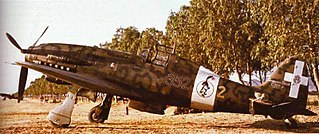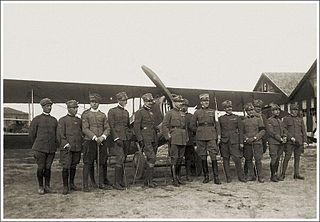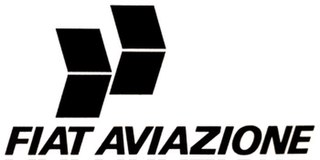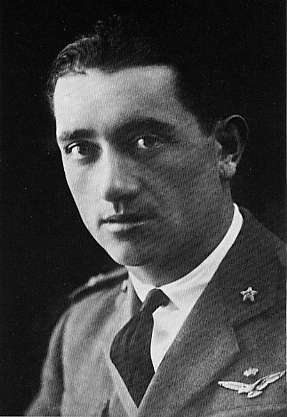
The Macchi C.200 Saetta, or MC.200, was a fighter aircraft developed and manufactured by Aeronautica Macchi in Italy. Various versions were flown by the Regia Aeronautica who used the type throughout the Second World War.

The Macchi C.205Veltro was an Italian World War II fighter aircraft built by the Aeronautica Macchi. Along with the Reggiane Re.2005 and Fiat G.55, the Macchi C.205 was one of the three "Serie 5" Italian fighters built around the powerful Daimler-Benz DB 605 engine. The C.205 was a development of the earlier C.202 Folgore. With a top speed of some 640 km/h (400 mph) and equipped with a pair of 20 mm cannon as well as 12.7 mm Breda machine guns, the Macchi C.205 Veltro was highly respected by Allied and Axis pilots alike. Widely regarded as one of the best Italian aircraft of World War II, it proved to be extremely effective, destroying a large number of Allied bombers. The Macchi C. 205 proved capable of meeting fighters such as the North American P-51D Mustang on equal terms, which encouraged the Luftwaffe to use a number of these aircraft to equip one Gruppe.
The Royal Italian Air Force (RAI) was the name of the air force of the Kingdom of Italy. It was established as a service independent of the Royal Italian Army from 1923 until 1946. In 1946, the monarchy was abolished and the Kingdom of Italy became the Italian Republic, whereupon the name of the air force changed to Aeronautica Militare.

The Fiat CR.32 was an Italian biplane fighter used in the Spanish Civil War and the Second World War. Designed by the aeronautical engineer Celestino Rosatelli, it was a compact, robust and highly manoeuvrable aircraft for its era, leading to it being a relatively popular fighter during the 1930s.

The Fiat G.50 Freccia ("Arrow") was a World War II Italian fighter aircraft that was developed and manufactured by the aviation company Fiat. Upon entering service, the type became Italy’s first single-seat, all-metal monoplane that had an enclosed cockpit and retractable undercarriage. On 26 February 1937, the G.50 conducted its maiden flight. During early 1938, the Freccias served in the Regia Aeronautica and with its expeditionary arm, the Aviazione Legionaria, in Spain, where they compared well in speed and manoeuvrability with their adversaries in the theatre.

Major Adriano Visconti di Lampugnano was one of Italy's top flying aces of the Second World War, shooting down between 10 and 26 enemy aircraft. He was awarded with four Medaglia d'argento al Valor Militare and two Medaglia di Bronzo al Valor Militare "in action".

The Macchi M.39 was a racing seaplane designed and built by the Italian aircraft company Aeronautica Macchi in 1925–26. An M.39 piloted by Major Mario de Bernardi (1893–1959) won the 1926 Schneider Trophy, and the type also set world speed records that year.
Breda-SAFAT was an Italian weapons manufacturer of the 1930s and 1940s that designed and produced a range of machine-guns and cannon primarily for use in aircraft. Based on the M1919 Browning machine gun, the Italian guns were chambered to fire indigenous ammunition with 7.7 mm (0.303 in) and 12.7 mm (0.500 in) calibres, predominantly ball, tracer for the 7.7mm, including high explosive incendiary tracer (HEI-T), or armour-piercing (AP) for the 12.7mm.

Mario de Bernardi (1893–1959) was an Italian World War I fighter pilot, seaplane air racer of the 1920s, and test pilot of early Italian experimental jets.
Officine Meccaniche Reggiane SpA was an Italian industrial manufacturer and aviation company.

Fiat Aviazione was an Italian aircraft manufacturer, at one time part of the Fiat group, focused mainly on military aviation. After World War I, Fiat consolidated several Italian small aircraft manufacturers, like Pomilio and Ansaldo. Most famous were the Fiat biplane fighter aircraft of the 1930s, the Fiat CR.32 and the Fiat CR.42. Other notable designs were the fighters CR.20, G.50, G.55 and a bomber, the Fiat BR.20. In the 1950s, the company designed the G.91 light ground attack plane.

The Italian Corpo Aeronautico Militare was formed as part of the Regio Esercito on 7 January 1915, incorporating the Aviators Flights Battalion (airplanes), the Specialists Battalion (airships) and the Ballonists Battalion. Prior to World War I, Italy had pioneered military aviation in the Italo-Turkish War during 1911–1912. Its army also contained one of the world's foremost theorists about the future of military aviation, Giulio Douhet; Douhet also had a practical side, as he was largely responsible for the development of Italy's Caproni bombers starting in 1913. Italy also had the advantage of a delayed entry into World War I, not starting the fight until 24 May 1915, but took no advantage of it so far as aviation was concerned.

Furio Niclot Doglio, MOVM was an Italian test pilot and World War II fighter pilot in the Regia Aeronautica. Doglio set nine world aviation records in the 1930s during his time as a test pilot. During the war, he claimed seven kills, flying FIAT G. 50s and Macchi C. 202s, establishing himself as one of Italy's aces. Doglio was killed in combat on 27 July 1942 during the Siege of Malta by George Beurling, who became Canada's top ace of the war. He was awarded a Medaglia d'oro al Valor Militare alla memoria.

Leonardo Ferrulli was an ace of the Regia Aeronautica, and a recipient of the Medaglia d'Oro al Valor Militare. He was credited with 22 air victories, one during the Spanish Civil War and 21 during World War II. He shot down Hurricanes, P-40s, P-38 Lightnings, Spitfires and B-17s, flying Fiat C.R.42 biplanes and Macchi C.200/202 monoplanes. His unit was 91a Squadriglia, 10° Gruppo, from 4° Stormo, one of the top-scoring fighter units of Regia Aeronautica.
Franco Lucchini, MOVM, was an Italian World War II fighter pilot in the Aviazione Legionaria and in the Regia Aeronautica. During World War II he achieved 21 individual air victories, plus 52 shared, to add to the five kills in Spain, during the Civil War.

Guido Fibbia was an Italian Second World War fighter pilot in the Regia Aeronautica and in the Aeronautica Nazionale Repubblicana. He was credited with 9 enemy planes shot down flying with biplanes Fiat C.R.32, Fiat C.R.42 and monoplanes Macchi C.200, C.202, C.205, Fiat G.50, G.55 and the German Messerschmitt Bf 109. He was decorated with two Silver Medal of Military Valor, one Bronze Medal of Military Valor, one Croce di Guerra and one German Iron Cross 2nd Class.

Officine Ferroviarie Meridionali or OFM was an Italian railway and rolling stock manufacturing company based at Naples.

Tommaso Dal Molin was an Italian fighter pilot and internationally prominent seaplane air racer and aerobatic pilot of the 1920s.
Alessandro Tonini was an important Italian aeronautical engineer and aircraft designer of the early 20th century who worked for Gabardini, Macchi, and IMAM.

The Fiat AS.8 was a large Italian 16-cylinder, liquid-cooled V configured aircraft racing engine designed and built in the late-1930s by Fiat for an attempt to capture the air speed record. Another reason for the design was to provide the Regia Aeronautica with high performance fighter aircraft engines.

















